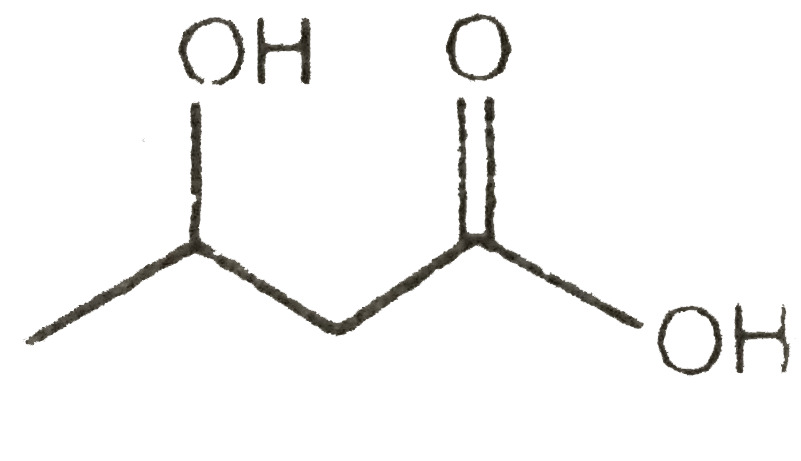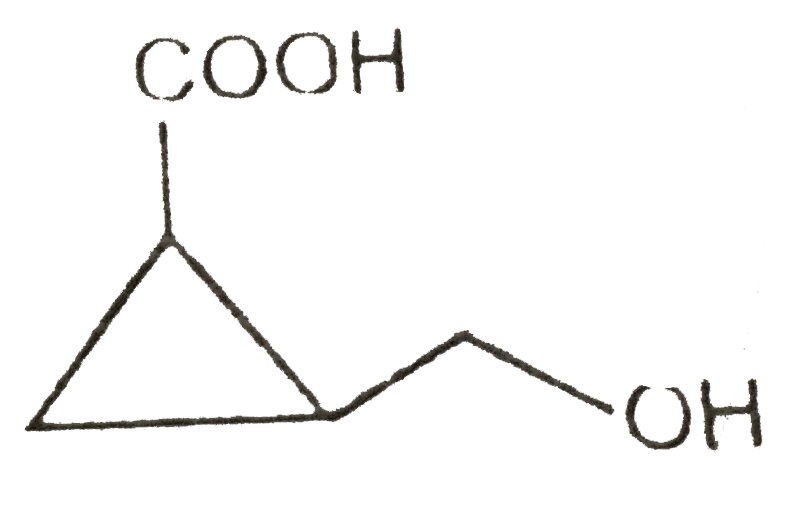C4H4O4 may be (Only structural )
1. Saturated dicarboxylicacid
2. Unsaturated dicarboxylic acid
3. Cyclic diester
4. Saturated di aldehyde
To determine which structural isomers are possible for the molecular formula C4H4O4, we will analyze each option based on the degree of unsaturation (DU) and the structural requirements of each type of compound.
1. Calculate the Degree of Unsaturation (DU):
The formula for calculating the degree of unsaturation is:
DU=C+1−H2
where C is the number of carbon atoms and H is the number of hydrogen atoms. For C4H4O4:
DU=4+1−42=5−2=3
This means the compound can have:
- 3 double bonds
- 1 double bond and 2 rings
- 3 rings
2. Evaluate Each Option:
- Option 1: Saturated Dicarboxylic Acid:
A saturated dicarboxylic acid would have no double bonds. However, since the DU is 3, this option is not possible because a saturated compound cannot have any degree of unsaturation.
- Option 2: Unsaturated Dicarboxylic Acid:
An unsaturated dicarboxylic acid can have double bonds. Since it can account for 2 degrees of unsaturation from the two carboxylic acid groups (COOH), and at least 1 more from an additional double bond, this option is valid. Thus, it can be represented as:
HOOC−CH=CH−COOH
This structure fits C4H4O4 and has a DU of 3.
- Option 3: Cyclic Diester:
A cyclic diester can also accommodate the degree of unsaturation. For example, a structure like:
Cyclic structure with two ester groups
can be drawn that fits the formula C4H4O4. This option is valid as well.
- Option 4: Saturated Dialdehyde:
A saturated dialdehyde would also have no double bonds, which would mean it cannot accommodate the degree of unsaturation of 3. Therefore, this option is not possible.
3. Conclusion:
The possible structural isomers for C4H4O4 are:
- Unsaturated Dicarboxylic Acid (Option 2)
- Cyclic Diester (Option 3)
Final Answer:
The correct options are 2 (Unsaturated Dicarboxylic Acid) and 3 (Cyclic Diester).
The formula for calculating the degree of unsaturation is:
DU=C+1−H2
where C is the number of carbon atoms and H is the number of hydrogen atoms. For C4H4O4:
DU=4+1−42=5−2=3
This means the compound can have:
- 3 double bonds
- 1 double bond and 2 rings
- 3 rings
- Option 1: Saturated Dicarboxylic Acid:
A saturated dicarboxylic acid would have no double bonds. However, since the DU is 3, this option is not possible because a saturated compound cannot have any degree of unsaturation.
- Option 2: Unsaturated Dicarboxylic Acid:
An unsaturated dicarboxylic acid can have double bonds. Since it can account for 2 degrees of unsaturation from the two carboxylic acid groups (COOH), and at least 1 more from an additional double bond, this option is valid. Thus, it can be represented as:
HOOC−CH=CH−COOH
This structure fits C4H4O4 and has a DU of 3.
A cyclic diester can also accommodate the degree of unsaturation. For example, a structure like:
Cyclic structure with two ester groups
can be drawn that fits the formula C4H4O4. This option is valid as well.
A saturated dialdehyde would also have no double bonds, which would mean it cannot accommodate the degree of unsaturation of 3. Therefore, this option is not possible.
The possible structural isomers for C4H4O4 are:
- Unsaturated Dicarboxylic Acid (Option 2)
- Cyclic Diester (Option 3)
The correct options are 2 (Unsaturated Dicarboxylic Acid) and 3 (Cyclic Diester).
Topper's Solved these Questions
- ISOMERISMBook:MOTIONChapter:ISOMERISMExercise:Exercise 1
Explore 51 Videos
- ISOMERISMBook:MOTIONChapter:ISOMERISMExercise:Exercise 2
Explore 50 Videos
- IONIC EQUILIBRUIMBook:MOTIONChapter:IONIC EQUILIBRUIMExercise:Exercise -4 (Level -II)
Explore 14 Videos
- LIQUID SOLUTIONBook:MOTIONChapter:LIQUID SOLUTIONExercise:EXERCISE-4 (Level-II) PREVIOUS YEAR JEE ADVANCED
Explore 19 Videos
Similar Questions
Molecular formula C4H4O4 can have various structures:
(i) a cyclic ester (A)
(i) a dibasic acid (B) that on heating is converted into acrylic acid.
(ii) a dibasic acid (C) that foms meso tartaric acid with alkaline KMnO4.
(iv) a dibasic acid (D) that forms racemic mixture of tartaric acid with alkaline KMnO4.
Assign structures to (A), (B), (C) and (D).
View SolutionMolecular formula C4H4O4 can have four isomers A,B,C and D: A is dicarboxylic acid giving racemic tartaric acid with alk. B is dicarboxylic acid giving meso tartaric acid with alk. KMnO4.
C is also dicarboxylic acid giving another monobasic acid on heating. D is cyclic ester Identify A ,B, C andD
View Solution
Knowledge Check
There are three isomeric compounds P,Q,R with molecular formula C4H6O3.Compound P is a saturated hydroxy carboxylic acid.Compound Q is a symmetrical anhydride while R is an aldehydic ester.
Which of the following is P?A B
B C
C D
D
There are three isomeric compounds P,Q,R with molecular formula C4H6O3.Compound P is a saturated hydroxy carboxylic acid.Compound Q is a symmetrical anhydride while R is an aldehydic ester.
Which of the following is the metamer of Q?ACH3−O∣∣C−O−O∣∣C−CH3BH−O∣∣C−O−O∣∣C−CH2−CH3CH−O∣∣C−O−CH2−O∣∣C−CH3DCH3−O−O∣∣C−O∣∣C−OCH32KMnO4+H2SO4+H2C2O4→K2SO4+2MnSO4+10CO2+8H2O Potassium permanganate oxidizes oxalic acid in acidic medium as per the above chemial reaction . Identify the coefficients of H2SO4andH2C2O4 in the above equation.
A3,5B4,4C5,3D4,2
(a) What are hydrocarbons? Explain it with examples.
(b) Explain the meaning of saturated and unsaturated hydrocarbons with one examples each.
(c) Give the names and structural formulae of one saturated cyclic hydrocarbon and one unsaturated cyclic hydrocarbon.
(d) Give one example of a hydrocarbon , other than pentane having more than three isomers.
(e) How many isomers of the following hydrocarbon are possible?
(i) C3H8,(ii)C4H10,(iii)C5H12,(iv)C6H14
View SolutionHow many isomers 'x' of C8H10 when reacts with hot alkaline KMnO4 give only aromatic dicarboxylic acid ? How many isomers 'y' of C4H8 when reacts with hot alkaline KMnO4 give carbondioxide ?
Sum of x+y=?
View SolutionDraw all the structural , stereo, and cyclic isomers of C4H6.
View SolutionAn unsaturated compound C6H12 A) decolourless Br2. Water and on oxidation by acidified KMnO4 gives optically active carboxylic acid C4H9COOH (B). Give the structure of (A) and (B).
View SolutionFind the solubility product of a saturated solution product of a saturated of Ag2CrO4 in water at 298K if the emf of the cell.
View Solution

